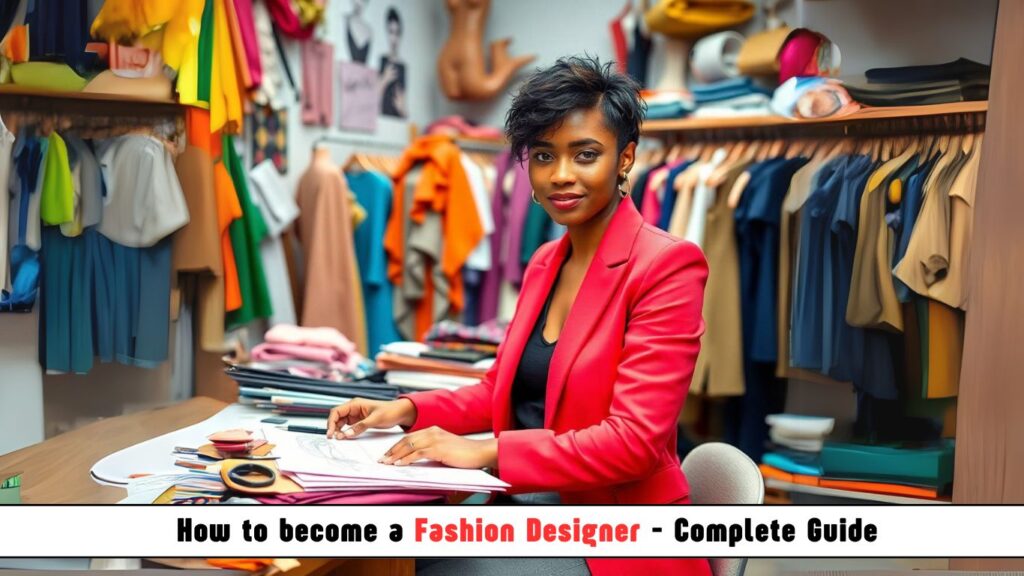
Introduction: The Art of Fashion Design
Fashion design is more than just creating clothes—it’s about storytelling, culture, and innovation. From haute couture runways to streetwear trends, fashion designers shape how people express themselves through clothing.
If you’ve ever dreamed of launching your own label, working for luxury brands like Chanel or Gucci, or revolutionizing sustainable fashion, this guide covers everything—from the history of fashion design to salary expectations, key responsibilities, and future career opportunities.
1. What is a Fashion Designer?
A Fashion Designer conceptualizes and creates clothing, accessories, and footwear. They:
- Sketch designs (by hand or digitally)
- Select fabrics, colors, and patterns
- Oversee production (from prototypes to final garments)
- Follow (or set) fashion trends
Fashion designers work in various sectors:
- Haute Couture (High-end, custom-made fashion)
- Ready-to-Wear (RTW) (Mass-produced collections)
- Sportswear & Streetwear (Nike, Supreme, Off-White)
- Sustainable Fashion (Eco-friendly materials & ethical production)
2. The History of Fashion Design
Fashion design has evolved alongside culture, technology, and social movements.
Early Beginnings (Pre-19th Century)
- 1700s: Marie Antoinette’s dressmaker, Rose Bertin, considered the first celebrity fashion designer.
- 1800s: Charles Frederick Worth (father of haute couture) established the first fashion house in Paris.
The Golden Age of Couture (1900s-1950s)
- 1920s: Coco Chanel popularized the “little black dress” and women’s trousers.
- 1947: Christian Dior’s “New Look” redefined post-war femininity.
- 1950s: Rise of ready-to-wear fashion (Yves Saint Laurent, Balenciaga).
Modern Fashion (1960s-Present)
- 1960s: Mary Quant introduced the miniskirt; youth culture dominated fashion.
- 1980s-90s: Japanese designers (Rei Kawakubo, Yohji Yamamoto) disrupted Western fashion norms.
- 2000s: Fast fashion (Zara, H&M) changed consumer habits.
- 2020s: Digital fashion (NFT clothing, virtual influencers) and sustainability dominate trends.
3. Roles and Responsibilities of a Fashion Designer
Fashion designers have diverse roles depending on their specialization:
1. Creative Direction
- Researching trends (Pinterest, WGSN, runway shows).
- Sketching designs (manually or using CAD software like Adobe Illustrator).
2. Fabric & Material Selection
- Choosing sustainable fabrics (organic cotton, recycled polyester).
- Working with textile manufacturers.
3. Pattern Making & Prototyping
- Creating patterns (draping, flat-pattern making).
- Developing samples with seamstresses.
4. Production & Quality Control
- Overseeing manufacturing (local or overseas).
- Ensuring ethical labor practices.
5. Marketing & Branding
- Collaborating with stylists, photographers, and influencers.
- Managing social media presence (Instagram, TikTok).
4. Salary of a Fashion Designer
Salaries vary by experience, location, and brand prestige.
Global Salary Breakdown (Annual)
| Country | Entry-Level | Mid-Level (3-5 yrs) | Senior-Level (5+ yrs) |
|---|---|---|---|
| USA | $40K – $60K | $60K – $90K | $90K – $200K+ |
| UK | £22K – £35K | £35K – £55K | £55K – £100K+ |
| India | ₹3L – ₹6L | ₹6L – ₹15L | ₹15L – ₹50L+ |
| France | €25K – €40K | €40K – €70K | €70K – €150K+ |
Top-Paying Sectors:
- Luxury Fashion (Chanel, Dior, Louis Vuitton)
- Sportswear (Nike, Adidas, Lululemon)
- Tech-Integrated Fashion (Wearable tech, 3D-printed clothing)
Freelance designers earn $30 – $150/hour depending on clients.
5. Qualifications & Skills Needed
A. Educational Background
- Bachelor’s Degree in Fashion Design (FIT, Parsons, Central Saint Martins).
- Short Courses (Pattern making, sustainable fashion, CAD).
B. Essential Skills
✅ Drawing & Illustration (Fashion sketches, mood boards).
✅ Sewing & Draping (Hands-on garment construction).
✅ CAD Software (Adobe Illustrator, CLO3D, Optitex).
✅ Trend Forecasting (WGSN, Pantone Color Institute).
✅ Business Acumen (Budgeting, branding, e-commerce).
C. Soft Skills
- Creativity & Innovation (Unique design perspective).
- Resilience (Handling rejection in a competitive industry).
6. How to Get Started in Fashion Design
Step 1: Build a Strong Foundation
- Take sewing classes.
- Study fashion history (books: The Fashion System by Roland Barthes).
Step 2: Develop Technical Skills
- Learn pattern making (YouTube, Skillshare).
- Master Adobe Illustrator & Photoshop.
Step 3: Create a Portfolio
- Include 10-15 sketches, technical flats, and finished garments.
- Showcase your unique aesthetic.
Step 4: Gain Experience
- Intern at fashion houses (even unpaid for experience).
- Assist stylists or costume designers.
Step 5: Launch Your Brand or Apply for Jobs
- Start small (Etsy, Instagram store).
- Apply for assistant designer roles at established brands.
7. Future of Fashion Design
The industry is evolving with technology and sustainability driving change.
A. Emerging Trends
- Digital Fashion (NFT clothing, virtual try-ons).
- 3D Printing (Custom-fit, zero-waste garments).
- AI in Design (Generative design algorithms).
B. Sustainable Fashion Growth
- Circular Fashion (Recycling old garments).
- Vegan Leather (Mushroom, pineapple leather).
C. Career Growth Paths
- Creative Director (Leading design teams).
- Costume Designer (Film, TV, theater).
- Fashion Tech Innovator (Smart fabrics, wearables).
Conclusion: Your Fashion Journey Starts Now
Fashion design is a competitive but rewarding career for those with passion and perseverance. Whether you dream of dressing A-list celebrities or launching a sustainable brand, the opportunities are endless.
Key Takeaways:
✔ Fashion designers blend creativity + technical skills.
✔ Salaries range from $40K – $200K+ depending on niche.
✔ Essential skills: sketching, sewing, trend forecasting.
✔ Future trends: digital fashion, sustainability, AI.
What’s Next?
- Start sketching daily.
- Enroll in a fashion design course.
- Build a standout portfolio.
The next iconic fashion revolution could be yours—start designing today! 👗✨













Post Comment